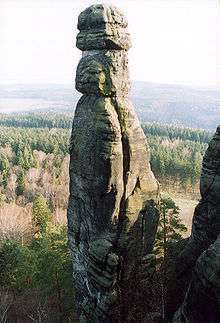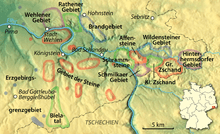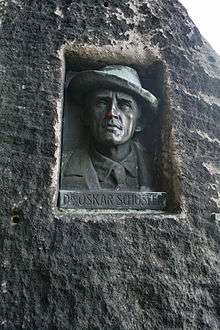Saxon Switzerland climbing region
Saxon Switzerland (German: Sächsische Schweiz) is one of the best-known climbing regions in Germany, located in the Free State of Saxony. The region is largely coterminous with the natural region of the same name, Saxon Switzerland, but extends well beyond the territory of the National Park within it. It includes the western part of the Elbe Sandstone Mountains and is the oldest non-Alpine climbing region in Germany. Its birth is usually reckoned to be the first ascent in modern times of the Falkenstein in 1864 by Bad Schandau gymnasts. Currently there are over 1,100 summits with more than 17,000 climbing routes in the Saxon Switzerland area.[1]

Climbing in Saxon Switzerland

Climbing in Saxon Switzerland has a number of aspects that are not found in other German climbing areas, or at least not to the same extent. There is a strong climbing ethic, which has been laid down in the Saxon Climbing Regulations since 1913 and is binding. This means that there are restrictions that must be observed in connexion with safety equipment and other climbing aids. Resources constraints must also be observed.
Restrictions on free-standing climbing peaks
The first peculiarity is that climbing is only permitted on free-standing climbing rocks with at least 10 m prominence, whilst in other climbing areas rock faces are often used. An historic exception are three massifs which may be climbed. Almost all summits are furnished with summit registers and abseiling rings. These, like other safety rings, are looked after and maintained by the Saxon Climbers' Federation (SBB).
Saxon Climbing Regulations

Climbing regulations for Saxon Switzerland were first printed in 1913 in a climbing guide published by Rudolf Fehrmann, and have remained largely unchanged to the present day. The basic principles had been developed before 1900, mainly by Oscar Schuster. Since then, the rules have only been slightly amended. Their main featured was, and is, that artificial aids to rock climbing are not permitted.
The climbing regulations are also part of the mountain sport concept required under the National Parks Ordinance for the Free State of Saxony, which lays down how and to what extent climbing in the Saxon Switzerland National Park may be undertaken. They thus have a regulating function, for example in the stipulations concerning Boofen, which is only permitted as part of climbing sport.
The most important regulations are:
- Artificial aids are forbidden. The climber is only allowed to use natural hand- and footholds and must use his own bodily strength to climb.
- Ropes, slings, carabiners, etc., may only be used for protection.
- The existing surface of the rock must not be altered (exceptions are safety rings).
- Safety rings may only be established by the first person to climb a route. The use of subsequent rings is decided by the sub-committee of the SBB responsible.
- The use of chalk is forbidden.
- Nuts, friends and similar aids are banned. Only slings may be used.
- Climbers must use their own strength to hold themselves in position and may not use other means, such as ropes, to support themselves.
- Initial ascents of a new climbing route may only be attempted from bottom to top. The opening of new routes by driving in pitons "from above" (i.e. by hanging off a rope from the summit or ledge) common in other climbing areas, is forbidden.
- Climbing is forbidden on wet or damp rocks, if depending on the rock, there is a risk of damage to the rock and of losing one's footing or handholds.
In addition the regulations go on to cover in detail the procedure for first ascents, climbing bans, the scale of climbing grades and conduct when climbing.
See also
- Schwedenturm, a popular climbing rock in Saxon Switzerland
References
- Sächsischer Bergsteiger Bund: Klettern im Elbsandsteingebirge
Sources
- Karl Däweritz: Klettern im sächsischen Fels. 2. erw. Auflage, Sportverlag, Berlin 1986, ISBN 3-328-00097-6.
- Dietmar Heinicke (Hrsg.): Kletterführer Sächsische Schweiz. Berg- & Naturverlag Rölke, Dresden 1999/2003 (6 Bände).
- Affensteine, Kleiner Zschand. 2002, ISBN 3-934514-05-7.
- Bielatal, Erzgebirgsgrenzgebiet. 2000, ISBN 3-934514-02-2.
- Gebiet der Steine. 2001, ISBN 3-934514-03-0
- Großer Zschand, Wildensteiner Gebiet, Hinterhermsdorfer Gebiet. 2001, ISBN 3-934514-04-9.
- Schrammsteine, Schmilkaer Gebiet. 1999, ISBN 3-934514-01-4.
- Wehlener Gebiet, Rathener Gebiet, Brandgebiet. 2003, ISBN 3-934514-06-5.
External links
| Wikimedia Commons has media related to Saxon Switzerland climbing region. |